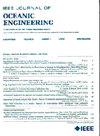Pulsed Laser Based Underwater Wireless Optical Communication: Smaller Channel Attenuation and Better Communication Performance
IF 3.8
2区 工程技术
Q1 ENGINEERING, CIVIL
引用次数: 0
Abstract
One of the primary goals in the development of underwater wireless optical communication (UWOC) is to extend the link length. Meanwhile, the key to increasing the link length of UWOC is to decrease the attenuation of the optical signals underwater. This work demonstrates that a decreased underwater attenuation coefficient and improved communication performance can be achieved by using a pulsed laser. The pulsed blue laser used in the experiment is a self-Q-switched semiconductor disk laser, whose Q-switching is initiated by the nonlinear Kerr effect of the multiple quantum wells in the active region of the gain chip. The width of the laser pulse is about a few nanoseconds and the repetition rate of the output pulse train is in the order of tens of megahertz. According to the measurements of the attenuation coefficients at various concentrations of Maalox solution, the pulsed laser has a significantly smaller attenuation coefficient than the continuous-wave laser, and this drop in attenuation coefficient is particularly noticeable in turbid water with a higher concentration of Maalox solution. The attenuation coefficient of the pulsed laser was only 62% of the continuous-wave laser at a Maalox concentration of 2905 mg·m−3. Subsequent tests reveal that the lower attenuation coefficient of the pulsed laser is mainly resulted from the reduced scattering it encounters underwater, rather than the ignorable decrease in the attenuation coefficient raised from the water's absorption of the laser. A UWOC system based on the above pulsed laser has also been built and much better communication performance compared to the continuous-waves laser has been obtained. The bit error rate of the UWOC based on the pulsed laser is 1–2 orders of magnitude lower than that of the UWOC with a continuous-wave laser when the data rate is 10 Mb/s and the link length is 18 m.基于脉冲激光的水下无线光通信:更小的信道衰减和更好的通信性能
水下无线光通信(UWOC)发展的主要目标之一是延长链路长度。同时,增加UWOC链路长度的关键是减小水下光信号的衰减。这项工作表明,使用脉冲激光可以降低水下衰减系数,提高通信性能。实验中使用的脉冲蓝色激光器为自调q半导体圆盘激光器,其调q是由增益芯片有源区多个量子阱的非线性克尔效应引发的。激光脉冲的宽度约为几纳秒,输出脉冲序列的重复频率约为几十兆赫兹。通过对不同浓度Maalox溶液衰减系数的测量,脉冲激光的衰减系数明显小于连续波激光,并且在Maalox溶液浓度较高的浑浊水中衰减系数的下降尤为明显。Maalox浓度为2905 mg·m−3时,脉冲激光的衰减系数仅为连续波激光的62%。随后的测试表明,脉冲激光衰减系数的降低主要是由于其在水下遇到的散射减少,而不是由于水对激光的吸收而引起的衰减系数的降低。在此基础上建立了UWOC系统,取得了比连续波激光器更好的通信性能。当数据速率为10 Mb/s,链路长度为18 m时,脉冲激光UWOC的误码率比连续波激光UWOC的误码率低1 ~ 2个数量级。
本文章由计算机程序翻译,如有差异,请以英文原文为准。
求助全文
约1分钟内获得全文
求助全文
来源期刊

IEEE Journal of Oceanic Engineering
工程技术-工程:大洋
CiteScore
9.60
自引率
12.20%
发文量
86
审稿时长
12 months
期刊介绍:
The IEEE Journal of Oceanic Engineering (ISSN 0364-9059) is the online-only quarterly publication of the IEEE Oceanic Engineering Society (IEEE OES). The scope of the Journal is the field of interest of the IEEE OES, which encompasses all aspects of science, engineering, and technology that address research, development, and operations pertaining to all bodies of water. This includes the creation of new capabilities and technologies from concept design through prototypes, testing, and operational systems to sense, explore, understand, develop, use, and responsibly manage natural resources.
 求助内容:
求助内容: 应助结果提醒方式:
应助结果提醒方式:


